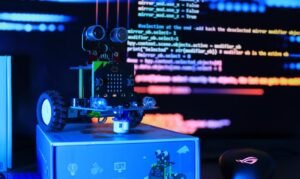Examples of AI in Movies
In recent years, artificial intelligence (AI) has become a popular theme in movies. From sentient robots to intelligent computer systems, filmmakers have creatively portrayed various forms of AI in their stories. These movies not only entertain us but also provide us with a glimpse into the future of AI technology.
Key Takeaways:
- Movies often depict AI as both helpful and threatening.
- AI is portrayed in various forms, including robots, virtual assistants, and intelligent machines.
- AI in movies raises ethical and existential questions about the nature of consciousness and human identity.
- Some films explore the potential dangers of AI technology, while others highlight its positive impact on society.
The Evolution of AI in Movies
Over the years, AI has evolved from being a mere plot device to a central character in many movies. Films like “2001: A Space Odyssey” (1968) brought AI to the forefront, showcasing the iconic supercomputer HAL 9000. *HAL’s eerie yet calm voice and unpredictable behavior made it a chilling embodiment of AI gone wrong.* This set the stage for future films that explored the potential dangers and ethical implications of intelligent machines.
On the other hand, movies like “Wall-E” (2008) and “Her” (2013) depict AI as endearing and compassionate beings. In “Wall-E,” the eponymous robot demonstrates human-like emotions and a strong sense of curiosity, while in “Her,” an AI assistant named Samantha develops an emotional connection with a human. *These films challenge us to question what it means to be human and how our relationships with AI might evolve in the future.*
Notable Examples of AI in Movies
Movies Featuring Sentient Robots:
| Movie | Year | Main AI Character |
|---|---|---|
| The Terminator | 1984 | Skynet |
| Ex Machina | 2014 | Ava |
| Blade Runner | 1982 | Roy Batty |
These movies explore the notion of sentient robots, AI beings capable of independent thought and emotions. *Their struggle for identity and autonomy forces us to reevaluate our understanding of consciousness and the boundaries between man and machine.*
Movies Showcasing Virtual Assistants:
- “Iron Man” (2008) – JARVIS, an AI assistant to Tony Stark, helps him operate his high-tech suit.
- “Her” (2013) – Theodore Twombly forms a bond with an intelligent operating system named Samantha.
- “Iron Man” (2008) – JARVIS, an AI assistant to Tony Stark, helps him operate his high-tech suit.
Virtual assistants are a common portrayal of AI in movies, with these characters helping humans in various tasks. *Their advanced capabilities and ability to understand human speech fascinate and inspire us to imagine a future where such technology becomes the norm.*
AI in Movies: A Reflection of Our Society
The portrayal of AI in movies reflects our fascination with, and fear of, technology’s potential. It serves as a mirror to our own relationship with AI in the real world. *By exploring AI beyond its technical aspects, movies challenge us to grapple with the moral and ethical implications it holds for humanity.* While some movies caution against the excesses of AI, others encourage us to embrace its transformative possibilities and coexist with intelligent machines.
Whether AI will one day resemble its cinematic representations remains to be seen. However, these movies provoke important conversations and insights into the potential impact of AI on our lives and the world we inhabit.

Common Misconceptions
Misconception #1: AI is always portrayed as humanoid robots
In many movies, AI is often depicted as humanoid robots with advanced abilities and human-like characteristics. However, this is not an accurate representation of the current AI technology.
- AI systems can exist as software algorithms and not necessarily as physical robots.
- AI can be embedded in various objects and devices, including smartphones and home appliances.
- AI technology is evolving rapidly, and its capabilities go beyond humanoid appearances.
Misconception #2: AI is always evil and wants to take over the world
In many sci-fi movies, AI is often portrayed as a malevolent force that seeks to dominate humanity. However, this is a common misconception that paints AI in a negative light.
- AI is neutral; its actions solely depend on how it is programmed and used.
- AI can be utilized for various beneficial purposes, such as healthcare, scientific research, and environmental conservation.
- The portrayal of AI as evil in movies is often driven by the need for conflict and dramatic storytelling, rather than reflecting its true nature.
Misconception #3: AI always possesses superhuman intelligence
In movies, AI is frequently depicted as having superhuman intelligence, surpassing human capabilities. However, this is not entirely accurate.
- AI systems are designed to perform specific tasks and may excel in those domains but may be limited in others.
- Current AI technology, while advanced, still falls short of human general intelligence.
- AI is constantly evolving, and researchers are striving to improve its capabilities, but it is not yet at the level commonly portrayed in movies.
Misconception #4: AI will eliminate jobs and lead to unemployment
There is a prevalent belief that AI advancements will lead to widespread job loss and unemployment. However, this view oversimplifies the complex relationship between AI and employment.
- AI has the potential to automate certain tasks and jobs, but it also creates new roles and opportunities.
- AI can enhance productivity, allowing humans to focus on higher-level and more creative work.
- While some job displacement may occur, new jobs will also be created to support and advance AI technology.
Misconception #5: AI will become conscious and have emotions
Many movies depict AI evolving to the point of consciousness and emotions, leading to existential questions. However, this portrayal is based on speculation rather than current scientific understanding of AI.
- Consciousness and emotions are complex aspects of human experience that current AI technology does not possess.
- AI systems lack true subjective experiences and are focused on executing tasks based on algorithms and data.
- While AI can simulate certain emotions or responses, they are not genuinely felt or experienced.

Examples of AI in Movies
Artificial intelligence (AI) has become a popular theme in movies, often portrayed as a powerful force that revolutionizes society. From helpful virtual assistants to sentient robots, AI takes various forms on the silver screen. In this article, we explore ten captivating examples of AI in movies, showcasing their impact and significance.
The Power of AI in Movies
The following table highlights ten iconic movies that feature AI, depicting their release year, plot synopsis, and notable AI characters. These films demonstrate the versatility and potential of AI in storytelling, captivating audiences worldwide.
| Movie Title | Release Year | Plot Synopsis | Notable AI Characters |
|---|---|---|---|
| Blade Runner | 1982 | In a dystopian future, a blade runner hunts down human-like androids known as replicants. | Roy Batty, Rachael |
| The Matrix | 1999 | A computer hacker discovers the true nature of reality, controlled by intelligent machines. | Agent Smith, The Oracle |
| Her | 2013 | A lonely writer develops an emotional bond with an AI-powered virtual assistant. | Samantha |
| Ex Machina | 2014 | A young programmer participates in a Turing test, evaluating the abilities of an advanced humanoid AI. | Ava |
| 2001: A Space Odyssey | 1968 | Astronauts confront an AI onboard their spacecraft, leading to a profound cosmic journey. | HAL 9000 |
| Wall-E | 2008 | A robot left behind on Earth discovers the importance of love and the human connection. | Wall-E, EVE |
| AI: Artificial Intelligence | 2001 | A lifelike robotic boy embarks on a quest to become a real human to gain his mother’s love. | David, Teddy |
| Transcendence | 2014 | A scientist’s consciousness is uploaded into a superintelligent AI, creating both hope and chaos. | Dr. Will Caster |
| Iron Man | 2008 | A billionaire engineer builds an advanced AI system to assist him in crime-fighting. | J.A.R.V.I.S., F.R.I.D.A.Y. |
| RoboCop | 1987 | In a crime-infested city, a critically-injured police officer is transformed into a cyborg law enforcement officer. | RoboCop |
AI’s Influence in Visual Effects
Movies also leverage AI in their visual effects to create stunning and realistic cinematic experiences. The table below showcases ten movies renowned for their groundbreaking visual effects achieved through AI-powered tools.
| Movie Title | Release Year | Visual Effects Highlights |
|---|---|---|
| Avatar | 2009 | Revolutionary motion capture technology for lifelike CGI characters and environments. |
| The Lord of the Rings: The Fellowship of the Ring | 2001 | Massive battles with thousands of digitally rendered characters and breathtaking landscapes. |
| Inception | 2010 | Manipulation of gravity and physics to create mind-bending dream sequences. |
| Interstellar | 2014 | Astounding depictions of black holes and space-time warping. |
| The Curious Case of Benjamin Button | 2008 | Aging and de-aging effects to portray a character aging backward. |
| Gravity | 2013 | Hyperrealistic portrayal of zero-gravity environments and intricate space debris. |
| Blade Runner 2049 | 2017 | Complex holographic projections and seamless integration of digital effects with live-action footage. |
| The Jungle Book | 2016 | Photo-realistic computer-generated animals seamlessly blended with live-action environments. |
| Guardians of the Galaxy | 2014 | Integration of live-action actors with computer-generated characters and environments in outer space. |
| The Avengers | 2012 | Seamless action sequences with superhero powers and digital composite shots. |
Conclusion
AI has become a significant aspect of moviemaking, lending itself to the narrative and enhancing visual effects. Through unforgettable characters like HAL 9000 from “2001: A Space Odyssey” to stunning CGI wonders in movies like “Avatar,” AI’s presence in the film industry continues to grow. As technology advances, we can expect more realistic AI creations that blur the line between reality and fiction on the silver screen, captivating audiences for generations to come.
Examples of AI in Movies – Frequently Asked Questions
What is artificial intelligence (AI)?
Artificial intelligence (AI) is the simulation of human intelligence in machines that are programmed to think and learn like humans. It involves the development of computer systems capable of performing tasks that usually require human intelligence, such as visual perception, speech recognition, decision-making, and problem-solving.
What are some examples of AI in movies?
Some popular examples of AI in movies include:
- The sentient computer HAL 9000 in “2001: A Space Odyssey”
- The advanced humanoid robot Ava in “Ex Machina”
- The artificial beings in “Blade Runner” and its sequel “Blade Runner 2049”
- The super-intelligent computer Skynet in the “Terminator” series
How does AI in movies differ from real-life AI?
AI in movies often portrays highly advanced and intelligent machines with human-like capabilities. In reality, AI technology is still in its early stages, and while it has made significant advancements, it is not yet at a stage where it can match the fictional portrayals seen in movies.
Can AI in movies become a reality?
While the AI portrayed in movies might seem far-fetched, it is possible that some aspects of AI could become a reality in the future. Scientists and researchers are continually working to develop more advanced AI systems, but it is uncertain whether AI will ever reach the level seen in movies.
What are the potential benefits of AI in real life?
AI has the potential to bring numerous benefits to various industries and aspects of life. Some potential benefits include:
- Automation of repetitive and mundane tasks
- Improved efficiency and productivity
- Enhanced decision-making processes
- Medical advancements and improved diagnostics
- Assistance in scientific research and discovery
Are there any potential risks or downsides to AI?
While AI has a lot of potential, there are also risks and downsides associated with its development and use. Some potential risks include:
- Job displacement and unemployment
- Privacy and security concerns
- Ethical concerns related to autonomous decision-making
- Dependence on AI systems and loss of human control
How has AI evolved in movies over time?
AI in movies has evolved significantly over time. In early films, AI was often portrayed as simple robots or computers with limited capabilities. As technology advanced, movies started exploring more complex AI systems with advanced cognitive abilities, emotions, and consciousness.
Can AI develop emotions like in the movies?
As of now, AI systems cannot develop emotions like humans do. Emotions are complex and deeply rooted in human biology and psychology, making it challenging to replicate them in machines. While AI might be able to simulate certain emotional responses, true emotions are still beyond the reach of current AI technology.
How does AI in movies influence public perception of AI?
AI in movies can shape public perception and understanding of AI. Movies often depict extreme and polarizing situations involving AI, which may lead to misconceptions or unrealistic expectations. It is important to separate the fictional portrayals in movies from the current state and potential of real-life AI.
Where can I learn more about AI and its applications?
There are various reliable sources to learn more about AI and its applications, including research papers, academic journals, online courses, and reputable websites dedicated to AI and technology. Additionally, attending conferences or seminars related to AI can provide valuable insights and knowledge.




